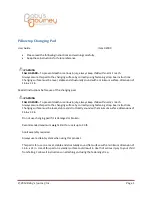
19
BOSCH PERFORMANCE LINE
Bicycle Owner’s Manual
19
d. Which gear should I be in?
The combination of largest rear and smallest front
gears (fig. 16) is for the steepest hills. The smallest rear
and largest front combination is for the greatest speed. It
is not necessary to shift gears in sequence. Instead, find
the “starting
gear” which
is right for
your level of
ability — a gear
which is hard
enough for quick
acceleration
but easy
enough to let
you start from
a stop without
wobbling — and
experiment with upshifting and downshifting to get a
feel for the different gear combinations. At first, practice
shifting where there are no obstacles, hazards or other
traffic, until you’ve built up your confidence. Learn not
to use either the “smallest to smallest” or “largest to
largest” gear combinations because they may cause
unacceptable stress on the drive train. Learn to anticipate
the need to shift, and shift to a lower gear
before
the hill
gets too steep. If you have difficulties with shifting, the
problem could be mechanical adjustment. See your dealer
for help.
WARNING: Never shift a derailleur onto the largest
or the smallest sprocket if the derailleur is not
shifting smoothly. The derailleur may be out of
adjustment and the chain could jam, causing you to lose
control and fall.
e. What if it won’t shift gears?
If moving the shift control one click repeatedly fails to
result in a smooth shift to the next gear chances are that
the mechanism is out of adjustment. Take the bike to your
dealer to have it adjusted.
2. How an internal gear hub drivetrain works
If your bicycle has an internal gear hub drivetrain, the
gear changing mechanism will consist of:
• a 3, 5, 7, 8, 11, 12, 14, 18 speed or possibly an
infinitely variable internal gear hub
• one, or sometimes two shifters
• one or two control cables
• one front sprocket called a chainring
• a drive chain
a. Shifting internal gear hub gears
Shifting with an internal gear hub drivetrain is simply a
a. Shifting Gears
There are several different types and styles of shifting
controls: levers, twist grips, triggers, combination shift/
brake controls and push-buttons. Ask your dealer to
explain the type of shifting controls that are on your bike,
and to show you how they work.
The vocabulary of shifting can be pretty confusing. A
downshift is a shift to a “lower” or “slower” gear, one
which is easier to pedal. An upshift is a shift to a “higher”
or “faster”, harder to pedal gear. What’s confusing is that
what’s happening at the front derailleur is the opposite
of what’s happening at the rear derailleur (for details,
read the instructions on Shifting the Rear Derailleur
and Shifting the Front Derailleur below). For example,
you can select a gear which will make pedaling easier
on a hill (make a downshift) in one of two ways: shift
the chain down the gear “steps” to a smaller gear at the
front, or up the gear “steps” to a larger gear at the rear.
So, at the rear gear cluster, what is called a downshift
looks like an upshift. The way to keep things straight is to
remember that shifting the chain in towards the centerline
of the bike is for accelerating and climbing and is called
a downshift. Moving the chain out or away from the
centerline of the bike is for speed and is called an upshift.
Whether upshifting or downshifting, the bicycle
derailleur system design requires that the drive chain is
moving forward and be under at least some tension. A
derailleur will shift only if you are pedaling forward.
CAUTION: Never move the shifter while pedaling
backward, nor pedal backwards immediately after
having moved the shifter. This could jam the chain
and cause serious damage to the bicycle.
b. Shifting the Rear Derailleur
The rear derailleur is controlled by the right shifter.
The function of the rear derailleur is to move the
drive chain from one gear sprocket to another. The
smaller sprockets on the gear cluster produce higher
gear ratios. Pedaling in the higher gears requires greater
pedaling effort, but takes you a greater distance with
each revolution of the pedal cranks. The larger sprockets
produce lower gear ratios. Using them requires less
pedaling effort, but takes you a shorter distance with each
pedal crank revolution. Moving the chain from a smaller
sprocket of the gear cluster to a larger sprocket results in
a downshift. Moving the chain from a larger sprocket to
a smaller sprocket results in an upshift. In order for the
derailleur to move the chain from one sprocket to another,
the rider must be pedaling forward.
c. Shifting the Front Derailleur:
The front derailleur, which is controlled by the left
shifter, shifts the chain between the larger and smaller
chainrings. Shifting the chain onto a smaller chainring
makes pedaling easier (a downshift). Shifting to a larger
chainring makes pedaling harder (an upshift).
Содержание bosch performance series
Страница 1: ...1 BOSCH PERFORMANCE LINE MANUAL GAZELLE WITH BOSCH PERFORMANCE LINE SYSTEM ...
Страница 71: ...37 BOSCH PERFORMANCE LINE ...
Страница 72: ...38 GAZELLE MANUAL ...
Страница 73: ...39 BOSCH PERFORMANCE LINE ...
Страница 74: ...ROYAL DUTCH GAZELLE N V Wilhelminaweg 8 6951 BP Dieren The Netherlands ...
















































